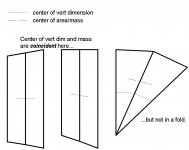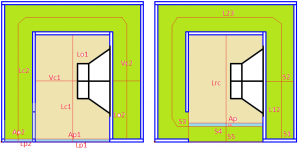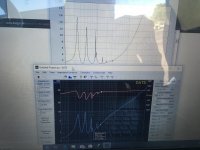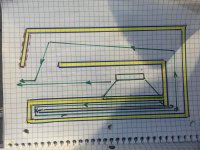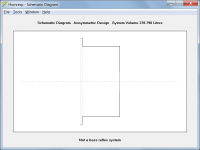Yes, MJK’s models and HornResp can get you to the same place, and sadly MArtin’s is NLA.
I find the graphs people post of Hornresp sims are hard to read. David has shown that daming can be added to better show the end result, but few seem to take advanatge of that.
Caveat: They both only run on Windoz so i do not use either. Scott does all the horns and TLs.
dave
Well darnit! We need to get you an old laptop 🙂 damping by csa? Or stuffing? I prefer to try and get it as well as i can to stsrt (no stuffing) but this rabbitt hole is in segments of 3 not being shown. 3/6/9/12 it adds up. Folding, predictable folding.
Whats missing can be guessed if within the confines of of somesort of pattern?
—so guys like me can bug you with questions, haaa!
Last edited:
I have a Windoz boz. MacPro with Windoz. It is a terrible OS. I do not willomgly use it.
dave
dave
I have a Windoz boz. MacPro with Windoz. It is a terrible OS. I do not willomgly use it.
dave
theres something here to see. its worth it! This thing im speaking of is repetative but not shown is the part i dont understand or could measure very well to show. i think its the folding and that makes phase sense. But im failing to describe this and even if its details blur, the fact remains theres a pattrn in folding to assume if setting up thst layout for it. Offset driver folded is missing a detail we can see again at a doubled down on in tapped horn? Still not shown but divide thru it and its offset
4 segments split by the flipping phase each. Fold or driver entry or exit? I dunno, but it can be seen as the pattern continues in many ways
Last edited:
Axial path in a fold follows center of mass?
The (exponential) horn data export from hornresp can be used to create a sequence of vertical dimension "ribs" given a fixed width. My intuition is that axial path follows the the center of mass. Is that correct?
In an unfolded horn, for each adjacent slice of volume (see the image attached, where all three figures have the same area), the center of the vertical dimension and the center of mass are coincident, even if the design top-aligns the ribs against a panel, for example. But around a fold, the path following the center of mass is substantially longer than a path defined by the center of the vert dimension.
So, if true, after a horn is folded, I should measure the center-of-mass path and re-model the horn, which now has the same throat and mouth area, but a materially greater length, right?
The (exponential) horn data export from hornresp can be used to create a sequence of vertical dimension "ribs" given a fixed width. My intuition is that axial path follows the the center of mass. Is that correct?
In an unfolded horn, for each adjacent slice of volume (see the image attached, where all three figures have the same area), the center of the vertical dimension and the center of mass are coincident, even if the design top-aligns the ribs against a panel, for example. But around a fold, the path following the center of mass is substantially longer than a path defined by the center of the vert dimension.
So, if true, after a horn is folded, I should measure the center-of-mass path and re-model the horn, which now has the same throat and mouth area, but a materially greater length, right?
Attachments
Last edited:
The (exponential) horn data export from hornresp can be used to create a sequence of vertical dimension "ribs" given a fixed width. My intuition is that axial path follows the the center of mass. Is that correct?
In an unfolded horn, for each adjacent slice of volume (see the image attached, where all three figures have the same area), the center of the vertical dimension and the center of mass are coincident, even if the design top aligns the ribs against a panel, for example. But around a fold, the path following the center is substantially longer than a path defined by the center of the vert dimension.
So, if true, after a horn is folded, I should measure the center-of-mass path and re-model the horn, which now has the same throat and mouth area, but a materially greater length, right?
Okay, so instead use red ‘s’ and constant CSA in each. And create the idea in portions? i hope i dont confuse the idea, but im thinning the variables or removing potential blurr from a simpler observation point?
But put that horn on jupiter and what frequency? inthink theres a funny ‘mass’ issue to see what about the centifugal course that mass loads in a turn? its ellipse not a circle of mass through a turn. Theres an orbit briefly.
a gas through a manifold maybe...
but use steps instead and apply that in segments? Even better, full wave versions of qw segments.
Take it out to a middle to see the center. why is 1/3 offset 2/3 remaining a thing? And is it the same as folded segments of 3’s endfired?
taped horn entry centered in two single fold pipes? What do we expect to see? Ignoring the heat and losses elsewhere. What is phase or impedance intervals of it?
Last edited:
The (exponential) horn data export from hornresp can be used to create a sequence of vertical dimension "ribs" given a fixed width. My intuition is that axial path follows the the center of mass. Is that correct?
Look up the "Advanced Centerline Method". That provides the best way to approximate a horn's path around a bend.
Brian, can you clarify which one is BP and which is TH? And what are these shorthand for? Bandpass and ... or something else?
The one on the left is how I tried to sim it using a Hornresp BP6P (6th Order Parallel-Tuned Bandpass) sim. The one on the right is how I tried to sim the same enclosure using a Hornresp TH (Tapped Horn) sim. The measured results suggest that the TH sim is more accurate.
Both sims contain a few compromises. For the BP6P one, the sim assumes that the vent exits the front of the enclosure, not at the end of the mouth as pictured. For the TH one, the sim does not include the impact of the driver offset in the chamber (the sim assumes that the driver is located at the rear of the chamber Vrc, not at the side.
Attachments
Look up the "Advanced Centerline Method". That provides the best way to approximate a horn's path around a bend.
Fantastic, thanks!
In the first case (Fr1) the material is being used as absorbent filling, whereas in the second case (Fr) it is being used as acoustical lining.
The absorbent filling material model, while a very good one, can sometimes break down mathematically at high resistivity values, depending upon the circumstances (over-flows and under-flows are generated in the calculations - there is nothing that can be done about this). This is why there may sometimes be limits imposed on the input values that can be specified.
Acoustical lining uses a completely different model, but unfortunately it is not applicable to the absorbent filling material case.
Thank for the clarification. I think with some intuition there are enough clues to make some assumptions...it is likely that the type of attenuation that I receive with the acoustical lining can be reflected upon a vented design of the same volume...not exact, but a ball park view.
I created two new Hornresp sims, and when I went to close Hornresp, it did not prompt me to save like it normally does.
Hi Brian,
Would it be possible for you to detail a specific step-by-step sequence of actions that results in the problem, so that I can attempt to replicate the issue for myself?
Ideally, the first step in the sequence should be:
1. Create a copy of the default record by clicking the Add button.
Thanks,
David
It certainly is, thanks.
I am quite surprised that the predicted and measured results are as close as they are, considering the differences between the simulation model and the actual loudspeaker design.
If its a measure of your success with Hornresp and if it makes you appreciate things on your end as feedback:
Sketch is the shape of the layout, not to scale but to show character of the real and simmed impedance plots. 80 cm, 120cm and 240cm are kindof the general grouping and then theres 214 hz, and marks all over accordingly.. 430, 145, 180, 72, 36,etc... hard to see but wow
whatever is going on, it seems to be going on pretty good (accurate software results) In fact, this is an easy one. the folding is rather (evenly dispersed, sketch not to scale). Still trying to master the folding results if using some thing that is ‘different’ that pieces of the fundamental in segment lengths within the ‘Zd’ . Or guessing at the results of them being precisely at harmonic intervals or close?
Attachments
Last edited:
Is this a bug or implicit to the model and assumptions used.
You are really "pushing the envelope" with this one... 🙂.
The Hornresp bass reflex simulation model assumes that the inputs will be realistic and practical. In your example the port tube dimensions are such that the system is not really acting as a Helmholtz resonator, and the status messages produced may therefore become unpredictable as a result.
There are limits on just how far Hornresp models can be pushed, and for the results to remain valid. It is simply not possible to have checks in place for all the input values that users may choose to use.
GIGO - Garbage in, garbage out...
Attachments
I have had Hornresp close and not save more than once or twice. And I have tried to make an edit in the Loudspeaker Wizard, so I can hit Save there - and it still fails to save the record. My backup is to export the file, so I can load it, if I need to.
I have had Hornresp close and not save more than once or twice.
It would seem that there may be a bug somewhere, but without specific details of a test record, and the changes made to it that cause the problem, I cannot isolate the cause. Everything I have tried so far works just fine for me.
It would seem that there may be a bug somewhere
Brian, further to Post #11470, I really need your help with this one!
https://www.diyaudio.com/forums/subwoofers/119854-hornresp-1147.html#post6481390
You are really "pushing the envelope" with this one... 🙂.
The Hornresp bass reflex simulation model assumes that the inputs will be realistic and practical. In your example the port tube dimensions are such that the system is not really acting as a Helmholtz resonator, and the status messages produced may therefore become unpredictable as a result.
There are limits on just how far Hornresp models can be pushed, and for the results to remain valid. It is simply not possible to have checks in place for all the input values that users may choose to use.
GIGO - Garbage in, garbage out...
Okay. Excuse the greenhorn 🙂
Hi Brian,
Would it be possible for you to detail a specific step-by-step sequence of actions that results in the problem, so that I can attempt to replicate the issue for myself?
Ideally, the first step in the sequence should be:
1. Create a copy of the default record by clicking the Add button.
Thanks,
David
Hi Dave, I've been trying to recreate steps a couple of times now that caused the records not to be saved, but to no avail. It might have had something to do with creating two records and then going back and forth between them (which is what I did for my ODTL/TH comparison), but I've tried multiple different combinations of steps and haven't been able to reproduce it, sorry. if it happens again, I'll try to reproduce the issue as the steps I took would be a bit fresher in my mind.
record not save
Dave,
I have different scenario that it didn't prompts to save, it's as follows
open Hornresp
add
alter S1
tool
loudspeakers wizard
cancel
close Hornresp
yes
it's shown new record but the new data (s1) was not save
Dave,
I have different scenario that it didn't prompts to save, it's as follows
open Hornresp
add
alter S1
tool
loudspeakers wizard
cancel
close Hornresp
yes
it's shown new record but the new data (s1) was not save
Last edited:
I have had Hornresp close and not save more than once or twice.
Same here. I thought it was only me!
I must admit it always seemed strange to me that there's no "file/save".
So "add" is what's supposed to "save"?
Does "add" mean "start a new record" or "add the current record to the saved file in its current state? or other?
Eric
It would seem that there may be a bug somewhere, but without specific details of a test record, and the changes made to it that cause the problem, I cannot isolate the cause. Everything I have tried so far works just fine for me.
Hi David,
I will definitely try to pass along more details.
I wonder if there is a way to "force" a save manually, as we go along? This way, we wouldn't have to worry about whether it will prompt us to save as we exit.
- Home
- Loudspeakers
- Subwoofers
- Hornresp
